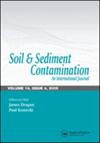Chromium chemistry and implications for environmental fate and toxicity
IF 1.5
4区 环境科学与生态学
Q4 ENVIRONMENTAL SCIENCES
引用次数: 162
Abstract
The same chemical properties that make chromium such an important component of so many industrial and consumer products are the important factors controlling its environmental fate and toxicity. Although only about 15% of the chromium mined is used in the manufacture of chromium chemicals, the chemistry of chromium is important in nearly all applications. For instance, the “stainless” nature of stainless steel is due to the chemical properties of the chromium oxides that form on the suriace of the alloy. Similarly, the product protection afforded by chrome plating of metals, CCA treatment of wood, and chrome tanning of leather is directly dependent on chromium chemistry. In all of these applications the most important chemical property is that under typical environmental and biological conditions of pH and oxidation‐reduction potential, the most stable form of chromium is the trivalent oxide. This form has very low solubility and low reactivity resulting in low mobility in the environment and low toxicity...铬的化学性质及其对环境命运和毒性的影响
使铬成为许多工业和消费品的重要组成部分的化学性质,也是控制其环境命运和毒性的重要因素。虽然开采的铬中只有大约15%用于制造铬化学品,但铬的化学性质在几乎所有应用中都很重要。例如,不锈钢的“不锈”性质是由于在合金表面形成的铬氧化物的化学性质。同样,金属镀铬、木材CCA处理和皮革镀铬鞣制所提供的产品保护也直接依赖于铬的化学作用。在所有这些应用中,最重要的化学性质是,在典型的pH和氧化还原电位的环境和生物条件下,铬的最稳定形式是三价氧化物。这种形式具有非常低的溶解度和低反应性,导致在环境中的低迁移率和低毒性。
本文章由计算机程序翻译,如有差异,请以英文原文为准。
求助全文
约1分钟内获得全文
求助全文
来源期刊

Soil & Sediment Contamination
环境科学-环境科学
CiteScore
4.20
自引率
10.00%
发文量
53
审稿时长
2.2 months
期刊介绍:
When it comes to assessing and mitigating contaminated soils and sediments, there is no substitute for having the very latest tools, techniques and methodologies at your fingertips to help you deal with these issues efficiently and cost-effectively.
This is just the kind of essential expertise you’ll only find in Soil and Sediment Contamination . This internationally, peer-reviewed publication focuses on soil and sediment contamination from:
-Sludges-
Petroleum-
Petrochemicals-
Chlorinated hydrocarbons-
Pesticides-
Lead and other heavy metals.
Get detailed descriptions of all the latest and most efficient offsite and in situ remediation techniques, strategies for assessing health effects and hazards, and tips for dealing with everyday regulatory and legal issues. With the state-of-the-art tools that Soil and Sediment Contamination provides, you can successfully assess, mitigate, and solve both rural and urban soil contamination problems as efficiently and economically as possible.
 求助内容:
求助内容: 应助结果提醒方式:
应助结果提醒方式:


